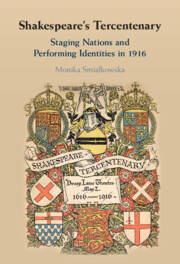Book contents
- Shakespeare’s Tercentenary
- Shakespeare’s Tercentenary
- Copyright page
- Dedication
- Contents
- Figures
- Acknowledgements
- Introduction
- Chapter 1 ‘Unser Shakespeare’? The Tercentenary and Germany
- Chapter 2 ‘Our English Shakespeare’? The Tercentenary and Britain
- Chapter 3 Shakespeare among the Allies
- Chapter 4 ‘Not Primarily Patriotic’? The Tercentenary and American National Identity
- Chapter 5 Voices from the Margins
- Conclusion
- Selected Bibliography
- Index
Chapter 4 - ‘Not Primarily Patriotic’? The Tercentenary and American National Identity
Published online by Cambridge University Press: 13 January 2024
- Shakespeare’s Tercentenary
- Shakespeare’s Tercentenary
- Copyright page
- Dedication
- Contents
- Figures
- Acknowledgements
- Introduction
- Chapter 1 ‘Unser Shakespeare’? The Tercentenary and Germany
- Chapter 2 ‘Our English Shakespeare’? The Tercentenary and Britain
- Chapter 3 Shakespeare among the Allies
- Chapter 4 ‘Not Primarily Patriotic’? The Tercentenary and American National Identity
- Chapter 5 Voices from the Margins
- Conclusion
- Selected Bibliography
- Index
Summary
This chapter discusses the enormous variety of Shakespeare Tercentenary celebrations in the US, examining events in diverse American locations. It considers how Americans used Shakespeare to build their national identity in the dual context of Britain’s attempts to establish an alliance with the still neutral US and of the uncertainties caused by the ‘new immigration’ from eastern and southern Europe. It uncovers Americans’ ambivalent attitudes towards their Anglo-Saxon heritage and conflicting views on the place of new immigrants within the nation. It demonstrates that the US Tercentenary celebrations promoted a more composite and diverse forms of American identity than a homogenising, Anglo-Saxonist model would allow. In 1916, Americans used Shakespeare to redefine their Anglo-Saxon heritage in order to accommodate new eastern and southern European immigrants. While this process appeared inclusive and liberal, it was often predicated on a systematic marginalisation of other ethnic and racial groups, particularly Native and African Americans. Thus, the US Tercentenary commemorations reflected the heterogeneous composition of the nation and exposed its deep-seated ethnic and racial divisions.
Keywords
- Type
- Chapter
- Information
- Shakespeare's TercentenaryStaging Nations and Performing Identities in 1916, pp. 173 - 228Publisher: Cambridge University PressPrint publication year: 2023

